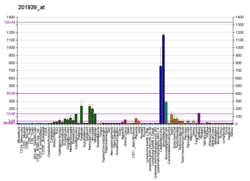PLK2
Protein-coding gene in the species Homo sapiens
| PLK2 | |||||||||||||||||||||||||||||||||||||||||||||||||||
|---|---|---|---|---|---|---|---|---|---|---|---|---|---|---|---|---|---|---|---|---|---|---|---|---|---|---|---|---|---|---|---|---|---|---|---|---|---|---|---|---|---|---|---|---|---|---|---|---|---|---|---|
| |||||||||||||||||||||||||||||||||||||||||||||||||||
| Identifiers | |||||||||||||||||||||||||||||||||||||||||||||||||||
| Aliases | PLK2, SNK, hPlk2, hSNK, polo like kinase 2 | ||||||||||||||||||||||||||||||||||||||||||||||||||
| External IDs | OMIM: 607023; MGI: 1099790; HomoloGene: 21317; GeneCards: PLK2; OMA:PLK2 - orthologs | ||||||||||||||||||||||||||||||||||||||||||||||||||
| |||||||||||||||||||||||||||||||||||||||||||||||||||
| |||||||||||||||||||||||||||||||||||||||||||||||||||
| |||||||||||||||||||||||||||||||||||||||||||||||||||
| |||||||||||||||||||||||||||||||||||||||||||||||||||
| |||||||||||||||||||||||||||||||||||||||||||||||||||
| Wikidata | |||||||||||||||||||||||||||||||||||||||||||||||||||
| |||||||||||||||||||||||||||||||||||||||||||||||||||
Serine/threonine-protein kinase PLK2 is an enzyme that in humans is encoded by the PLK2 gene.[5]
Serum-inducible kinase is a member of the 'polo' family of serine/threonine protein kinases that have a role in normal cell division. [supplied by OMIM][5]
References
- ^ a b c GRCh38: Ensembl release 89: ENSG00000145632 – Ensembl, May 2017
- ^ a b c GRCm38: Ensembl release 89: ENSMUSG00000021701 – Ensembl, May 2017
- ^ "Human PubMed Reference:". National Center for Biotechnology Information, U.S. National Library of Medicine.
- ^ "Mouse PubMed Reference:". National Center for Biotechnology Information, U.S. National Library of Medicine.
- ^ a b "Entrez Gene: PLK2 polo-like kinase 2 (Drosophila)".
Further reading
- Kauselmann G, Weiler M, Wulff P, et al. (1999). "The polo-like protein kinases Fnk and Snk associate with a Ca(2+)- and integrin-binding protein and are regulated dynamically with synaptic plasticity". EMBO J. 18 (20): 5528–39. doi:10.1093/emboj/18.20.5528. PMC 1171621. PMID 10523297.
- Ouyang B, Li W, Pan H, et al. (1999). "The physical association and phosphorylation of Cdc25C protein phosphatase by Prk". Oncogene. 18 (44): 6029–36. doi:10.1038/sj.onc.1202983. PMID 10557092.
- Holtrich U, Wolf G, Yuan J, et al. (2000). "Adhesion induced expression of the serine/threonine kinase Fnk in human macrophages". Oncogene. 19 (42): 4832–9. doi:10.1038/sj.onc.1203845. PMID 11039900.
- Liby K, Wu H, Ouyang B, et al. (2002). "Identification of the human homologue of the early-growth response gene Snk, encoding a serum-inducible kinase". DNA Seq. 11 (6): 527–33. doi:10.3109/10425170109041337. PMID 11696980. S2CID 46552280.
- Shimizu-Yoshida Y, Sugiyama K, Rogounovitch T, et al. (2002). "Radiation-inducible hSNK gene is transcriptionally regulated by p53 binding homology element in human thyroid cells". Biochem. Biophys. Res. Commun. 289 (2): 491–8. doi:10.1006/bbrc.2001.5993. PMID 11716500.
- Strausberg RL, Feingold EA, Grouse LH, et al. (2003). "Generation and initial analysis of more than 15,000 full-length human and mouse cDNA sequences". Proc. Natl. Acad. Sci. U.S.A. 99 (26): 16899–903. Bibcode:2002PNAS...9916899M. doi:10.1073/pnas.242603899. PMC 139241. PMID 12477932.
- Ma S, Liu MA, Yuan YL, Erikson RL (2003). "The serum-inducible protein kinase Snk is a G1 phase polo-like kinase that is inhibited by the calcium- and integrin-binding protein CIB". Mol. Cancer Res. 1 (5): 376–84. PMID 12651910.
- Matsuda A, Suzuki Y, Honda G, et al. (2003). "Large-scale identification and characterization of human genes that activate NF-kappaB and MAPK signaling pathways". Oncogene. 22 (21): 3307–18. doi:10.1038/sj.onc.1206406. PMID 12761501.
- Burns TF, Fei P, Scata KA, et al. (2003). "Silencing of the novel p53 target gene Snk/Plk2 leads to mitotic catastrophe in paclitaxel (taxol)-exposed cells". Mol. Cell. Biol. 23 (16): 5556–71. doi:10.1128/MCB.23.16.5556-5571.2003. PMC 166320. PMID 12897130.
- Ma S, Charron J, Erikson RL (2003). "Role of Plk2 (Snk) in mouse development and cell proliferation". Mol. Cell. Biol. 23 (19): 6936–43. doi:10.1128/MCB.23.19.6936-6943.2003. PMC 193943. PMID 12972611.
- Ota T, Suzuki Y, Nishikawa T, et al. (2004). "Complete sequencing and characterization of 21,243 full-length human cDNAs". Nat. Genet. 36 (1): 40–5. doi:10.1038/ng1285. PMID 14702039.
- Gerhard DS, Wagner L, Feingold EA, et al. (2004). "The status, quality, and expansion of the NIH full-length cDNA project: the Mammalian Gene Collection (MGC)". Genome Res. 14 (10B): 2121–7. doi:10.1101/gr.2596504. PMC 528928. PMID 15489334.
- Yogosawa S, Hatakeyama S, Nakayama KI, et al. (2006). "Ubiquitylation and degradation of serum-inducible kinase by hVPS18, a RING-H2 type ubiquitin ligase". J. Biol. Chem. 280 (50): 41619–27. doi:10.1074/jbc.M508397200. PMID 16203730.
- Kimura K, Wakamatsu A, Suzuki Y, et al. (2006). "Diversification of transcriptional modulation: large-scale identification and characterization of putative alternative promoters of human genes". Genome Res. 16 (1): 55–65. doi:10.1101/gr.4039406. PMC 1356129. PMID 16344560.
- Park YY, Kim SH, Kim YJ, et al. (2007). "Polo-like kinase 2 gene expression is regulated by the orphan nuclear receptor estrogen receptor-related receptor gamma (ERRgamma)". Biochem. Biophys. Res. Commun. 362 (1): 107–13. doi:10.1016/j.bbrc.2007.07.170. PMID 17706602.
- Matthew EM, Yen TJ, Dicker DT, et al. (2007). "Replication stress, defective S-phase checkpoint and increased death in Plk2-deficient human cancer cells". Cell Cycle. 6 (20): 2571–8. doi:10.4161/cc.6.20.5079. PMID 17912033.
- v
- t
- e
Serine/threonine-specific protein kinases (EC 2.7.11.21-EC 2.7.11.30) | |||||||||||||||||||||
|---|---|---|---|---|---|---|---|---|---|---|---|---|---|---|---|---|---|---|---|---|---|
| |||||||||||||||||||||
Dual-specificity kinases (EC 2.7.12) | |||
|---|---|---|---|
| |||
 | This article on a gene on human chromosome 5 is a stub. You can help Wikipedia by expanding it. |
- v
- t
- e


















